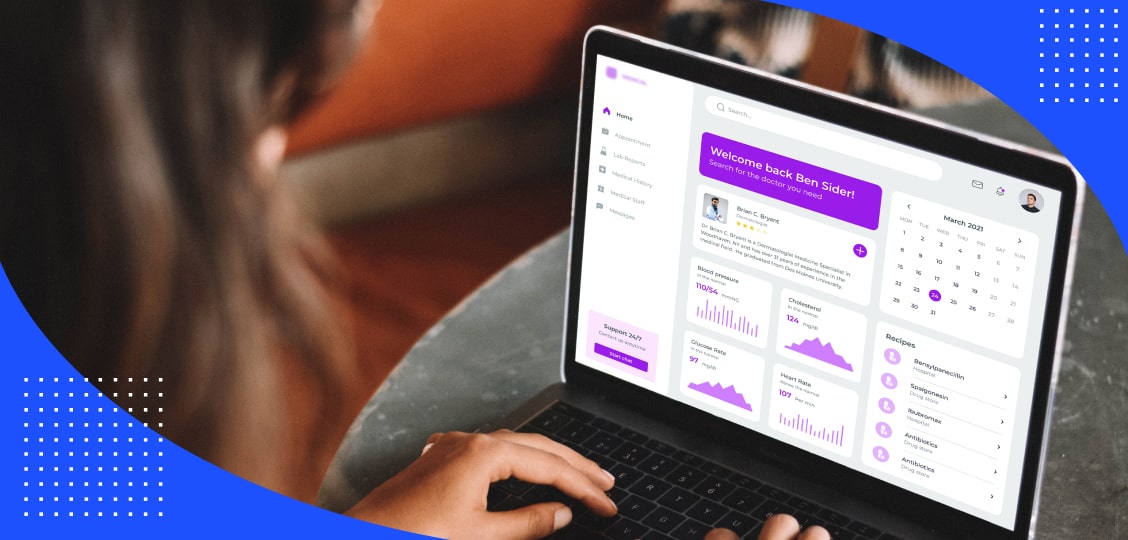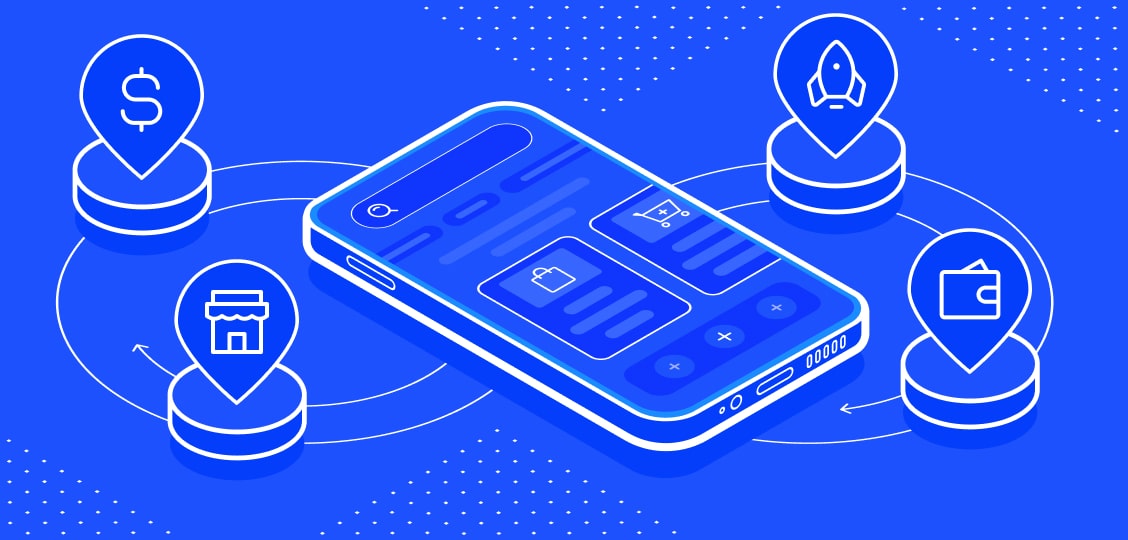How do you make a healthcare marketplace app like Zocdoc and what budget should you have?
How do you make a healthcare app like Zocdoc and how much does it cost? What budget should you have? Read the article to find out the answers.

With the increased penetration of the Internet and smartphones, the food delivery industry is witnessing rapid growth. Expert Market Research reports that the worldwide online food delivery market size is anticipated to spike from nearly $213 billion in 2020 to about $465 billion by 2026, progressing at a CAGR of 14.5% during the forecasted period.
The COVID-19 pandemic significantly affected the foodservice sector. Aiming to attract customers and ensure business continuity, many cafes and restaurants were forced to create user-friendly apps and websites that made food ordering a convenient process with no queues.
According to Bloomberg Second Measure, 50% of US consumers purchased meal delivery in September 2021, up from 44% compared to the previous year. It is worth noting that online food delivery marketplaces experienced a considerable startup valuation surge in the time of COVID-19, seeing a surge of 132%.
As the environment is as competitive as it has never been before, providers need to adopt new delivery models and innovative technologies. In this article, our software experts have described the main online food delivery trends for 2022, so that you can get ideas for business development. Have a look.
The popularity of online food delivery marketplaces has significantly climbed during coronavirus. With the view to stay operational and cut expenditures, cafes, restaurants, and grocery stores are registering on foodservice marketplaces.
This way, the demand for marketplace platforms similar to Uber Eats and DoorDash is increasing. These two companies have seen the most substantial growth in average spending per consumer over the past two years. For DoorDash, the average paycheck per customer in the third quarter of 2021 was 114% higher compared with that same time period of 2019.
At Uber Eats, the average sales check per client jumped by 92% in Q3 2021. Find out how to launch a food delivery app like Uber Eats, from features that you should implement to the required time and budget.
Other well-known online food delivery marketplaces, such as Grubhub and Postmates, also experienced sales uplift between 2019–2021. Since marketplaces provide a fast start and simplified access to the audience, this trend is poised to prevail in the dining environment.
Increase in average sales per customer at top food delivery marketplaces (Source: Bloomberg Second Measure)
As the market is expected to surge, investment in local food service marketplaces offers great investment opportunities. For instance, Wolt, a Finnish-based startup, was able to attract $530 million at the beginning of 2021. Established in 2014, Wolt managed to triple its revenue to $330 million against a net loss of $38 million.
Another successful local startup is Membo. Founded in 2020, Membo launched a marketplace app to bring together Estonian food producers and consumers. As of summer 2021, the platform served more than 800 items from 65 vendors in Tallinn and Tartu. To date, Membo has raised $125,000 over one round.
Mobile ordering is among the key online food delivery trends for 2022. When dining places were closed because of the COVID-19 pandemic, customers relied heavily on mobile-first food delivery services.
Mobile food app downloads hit virtually 170 million in Europe during the first three quarters of 2021, rising by 44% from the same period in 2019, according to Sensor Tower. Analysts predict that food application installs will reach over 60 million in Q4 2021.
As the demand for mobile ordering climbed, some well-known and large restaurant chains decided to design buildings to handle a growing number of orders. Restaurant Business informs that Burger King developed a prototype featuring a lane for mobile and delivery orders.
Chipotle Mexican Grill created its 100th “Chipotlane” to faster serve consumers ordering food via smartphones. This strategy was so effective that company owners are going to launch more lanes of this kind in the future. With a mobile application, Domino’s also witnessed a substantial upsurge in their digital sales that amounted to 75% during coronavirus.
A recent study found that 49% of survey participants would prefer to minimize human interactions by ordering and making payments, as well as booking tables via mobile devices. In this regard, the demand for marketplace development has risen. At Arateg, for example, our team has recently built a mobile food pre-ordering application for iOS and Android.
With the spread of the COVID-19 disease, robotic delivery witnessed an upsurge. MarketsandMarkets informs that the delivery robot market size is forecasted to spike from $212 million in 2021 to $957 million by 2026, registering a CAGR of 35.1% during the indicated period. The increasing adoption of innovative technologies, such as artificial intelligence, is poised to become a key market driver and provide great opportunities for businesses.
Robots are being actively adopted in the foodservice sector to automate the delivery process and meet the growing consumer demand. U.S. News reports that the number of delivery orders in the US rose by 66% in 2021 ending in June. Analysts also say that the popularity of robot-based meal delivery could remain high even after the ease of the pandemic.
Recruitment is another challenge many dining places aim to address using robots. According to U.S. News, 75% of US restaurant owners said that employee hiring and retention is their biggest issue. However, robots do not necessarily lead to delivery job losses but otherwise may help create them.
Drone delivery is one of the primary foodservice industry trends for 2022 and the coming years. Mordor Intelligence informs that the world’s delivery drones market is predicted to soar from $2 billion in 2020 to $5.6 billion by 2026, progressing at a CAGR of around 14% during the indicated period. Contactless delivery and convenience were the key market drivers in the wake of COVID-19. However, people expressed their interest in this model even before coronavirus.
A survey of 821 customers conducted in October 2019 revealed that 87% of participants reported positive sentiments regarding food delivery by drones. Furthermore, 89% of respondents stated that they were likely to use the service if it was available. In addition, 87% of consumers said they considered drone delivery on equal or even more favorable terms than other technology use cases.
Seeing unprecedented growth this year, ghost kitchens are one of the main online food delivery trends for 2022. According to Statista, the worldwide dark kitchen market size is anticipated to jump from $43.1 billion in 2019 to $71.4 billion by 2027. Euromonitor estimated that the global ghost kitchen market can account for $1 trillion by 2030.
Also known as virtual/cloud/dark kitchens and delivery-only restaurants, ghost kitchens do not provide customers with physical dining spaces but meal delivery and takeout services only. Allowing consumers to order food via mobile apps, websites, and phones, virtual kitchens enable cafes and restaurants to significantly reduce costs, which is especially important during disruptions such as the COVID-19 outbreak.
Customer loyalty has a direct impact on return on investment, allowing businesses across different sectors to boost user satisfaction and increase revenues. Techjury reports that 75% of people are more willing to interact with a company that offers a loyalty program.
Fundera found that consumers engaged with a delivered loyalty program spend 12–18% more with a brand each year. Another survey says that 90% of organizations considered improving or extending their loyalty programs as a priority in 2021.
Since customer loyalty brings various advantages, cafes, restaurants, and grocery stores are integrating specific programs into their online food delivery services. For example, many dining places and groceries use a points-based system, rewards (e.g., company merch, free meal delivery), discounts, and gamified experiences to engage existing and potential clients. Thanks to this, they manage to earn a higher income.
By creating a personalized user experience, cafes and restaurants improve customer engagement and raise the conversion rate. Employing data analytics solutions, companies can deliver individual recommendations based on user purchases, order history, in-app behavior, and location. Since personalization comes up with plenty of benefits, it is one of the most important food delivery industry trends for 2022.
PR Newswire reports that 55% of survey respondents would enjoy receiving tailored offers from dining places based on their location. It is worth remarking that 56% of participants would appreciate having control and visibility over who has access to the personal information they share with restaurants and driver-messengers.
Aiming to gain a competitive advantage, many cafes and restaurants are currently implementing personalized services. Blaze Pizza, for instance, launched a new mobile application in September 2021 to deliver an intuitive pizza customization process and enable personalized communication. The product suggests users make purchases based on their past meal orders. Providing a customer loyalty program, the application lists free items for each user individually to redeem their loyalty points for.
Consumers are motivated by personal offers but are only willing to share so much. It's incumbent upon restaurateurs to ensure they have a data strategy that allows them to deliver highly personalized offers, and that's where a smart mobile strategy really helps.
Following recent online food delivery trends is vital to gaining a competitive advantage, ensuring business continuity, and improving customer satisfaction. By using technological advancements like drones and robots, it is possible to increase efficiency, cut expenditures, and maximize return on investment. Thanks to personalized offers and loyalty programs, dining places and groceries can attract and retain the audience, resulting in higher profits.
If you aim to launch a food delivery solution, drop us a message. Our team will get back to you within 1 business day and help address all issues. With extensive experience in building online food delivery marketplaces, we will analyze your requirements and make an initial project estimation. Consultation is free of charge.

How do you make a healthcare app like Zocdoc and how much does it cost? What budget should you have? Read the article to find out the answers.

As the demand for marketplace platforms is witnessing rapid growth, investment in their development offers great opportunities. Explore the top online marketplace niches for 2022.
Now, you will receive a fresh newsletter from us.
Get the latest scoop on software application tips, announcements, and updates from us. Subscribe to our newsletter!